Sustainability: How does chicken production impact the environment? How is the chicken industry minimizing its environmental impact?
The chicken industry is committed to environmentally responsible and sustainable chicken production practices to ensure a healthier planet. After all, it takes a healthy planet, fresh water, fertile soil and clean air to raise and produce chicken.
For the chicken industry, sustainability means being responsible stewards of land, water and feed management, and maintaining and advocating for the humane treatment of our most important asset: our chickens.
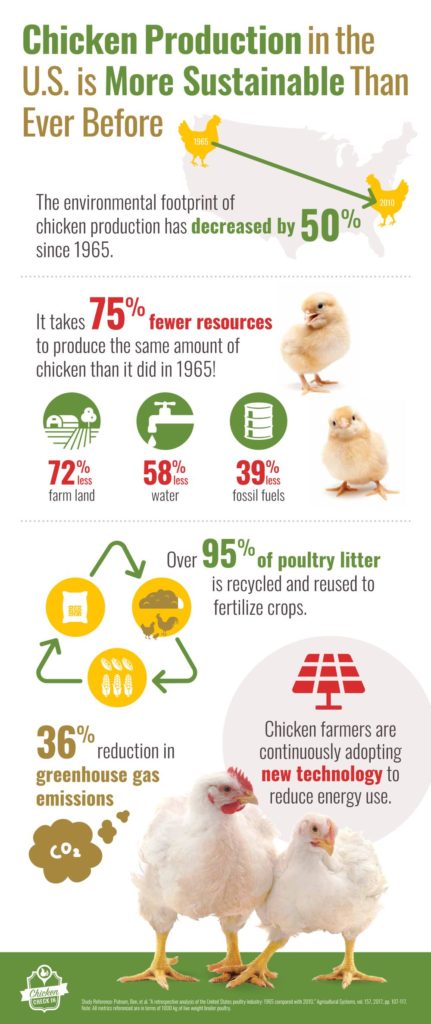
Through continuous innovation and by ensuring the best possible bird health, the chicken industry has been able to significantly reduce the use of water, farmland, electricity, greenhouse gasses, and other valuable resources.
In fact, producing the same amount of chicken today as 1965 has 50% less impact on the environment. Many factors have contributed to the reduced environmental impact of producing chicken, including:
- 75% fewer resources required in poultry production;
- 36% reduced impact of poultry production on greenhouse gas emissions;
- 72% decrease in farm land used in poultry production; and
- 58% decrease in water used in poultry production.
See sustainable chicken farming in action and learn what sustainability means to chicken farmers.
These improvements in environmental impact have gone hand-in-hand with improving bird health and welfare. All current measurable data – livability, disease, condemnation, digestive and leg health – reflect that the national broiler flock is healthier than it has ever been.
Chicken production has a smaller environmental footprint than almost any other animal agriculture industry, and we are continuing to develop and advance our sustainable and environmentally-friendly practices so that we leave the earth in better shape than we found it. We have made significant strides in minimizing environmental impact with the help of technological advancements and improved animal husbandry practices.
Now, let’s dive deeper into why chicken production in the United States is more sustainable today than ever before.
What is the water footprint of chicken production? Does chicken production use a lot of water?
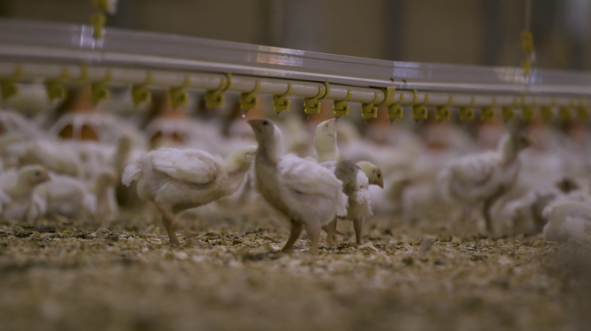
From the farm to your table, water is required throughout the various steps of chicken production. The chicken industry has actually reduced overall water usage by 58% since 1965.
There are several ways that water is used throughout the chicken production process.
- To water crops (namely corn and soybeans) for chicken feed
- For the chickens to drink on the farm
- To cool the birds via evaporative cooling cells during warmer temperatures
- To clean and sanitize equipment at the processing plant
How is water usage monitored and minimized on the chicken farm? What tools on the farm help reduce water usage?
Growout houses, the barns where broiler chickens live and grow, are equipped with computer systems that measure and monitor water usage on the farm. Farmers diligently watch for any abnormal water use patterns to help identify any problems such as water leaks, which saves water.
Most modern chicken farms use “nipple” watering systems as another water-saving tool. Nipple watering systems are pin activated water dispensers, much like a rabbit or hamster water bottle with the ball bearing. When the birds press the pin, water is released. This helps limit any water being spilled on the poultry litter, or floor, and it only dispenses water when the birds want to drink.
Most growout houses are also equipped with cooling systems that consist of cool cell pads, which evaporate water, at one end of the house and large tunnel exhaust fans at the other end. This not only keeps the chickens cool, but also recycles water on the farm.
See how chicken farmers reduce, save and recycle water.
Do chickens need a lot of food to grow? Does producing chicken feed have a high environmental impact?
Chicken feed is primarily a mix of corn and soybean meal that is formulated by certified animal nutritionists. This ensures that each bird gets the right nutrients, at the right time. Nutritious feed results in chickens requiring less food to grow. Chicken feed never contains added hormones or steroids – it’s the law.
You may be surprised to learn that growing corn and soybeans for the production of chicken feed is the largest source of water consumption in chicken production. In order to produce 1 pound of chicken, it only takes about 1.82 pounds of feed, one of the best rates in all of US animal agriculture. This is known as feed conversion. Fifty years ago, it took 2.4 pounds of feed. That might not sound like a lot, but when you are feeding 9 billion chickens each year, that’s a lot of land, water and emissions we are saving.
Chickens are the most efficient converters of feed into meat of all land-based livestock species due to several key factors:
- Traditional breeding
- Nutritious feed tailored to each stage of a chicken’s life
- Better living conditions through climate-controlled barns and new technology, and protection from extreme temperatures, predators and disease
- Up-to-date biosecurity practices
- Veterinary oversight
All of these factors result in chicken requiring less feed and water to grow to market weight which results in chicken having less of an environmental impact.
What about waste? How is poultry litter and manure used?
Chicken litter, or poultry litter, is not a waste product. In fact, it is an extremely valuable resource in agriculture. It is a mix of chicken manure, spilled feed, feathers, and material used for bedding in the houses.
In 2010, over 95% of broiler poultry litter was recycled. Farmers collect and store poultry litter to be used as an organic fertilizer for crops. Plants feed the chickens and chickens fertilize the plants – it’s a closed, sustainable nutrient loop.
Does poultry litter contaminate local water sources?
Farmers are required, by law, to follow what are called “Nutrient Management Plans” when fertilizing crops and managing animal manure. These plans specify how much fertilizer, manure or other nutrient sources may be safely applied to crops to achieve yields and prevent excess nutrients from impacting waterways. Nutrient Management Plans are generally required for all agricultural land used to produce plants, food, feed, fiber, animals or other agricultural products.
These Nutrient Management Plans protect water quality by ensuring that farmers and urban land managers apply fertilizers, animal manure and other nutrient sources in an effective and environmentally sound manner.
Farmers also minimize water runoff and emissions by planting vegetative buffers between chicken houses, which help to absorb any water, dust or emissions on the farm.
In addition, farmers install heavy use area concrete pads (HUA pads) around the entrances to each growout house to keep litter from being washed away. Litter that farmers do not immediately use is placed in a shed which further ensures that the litter does not enter local water sources.
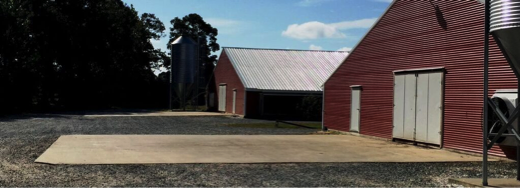
How is the chicken industry limiting energy use?
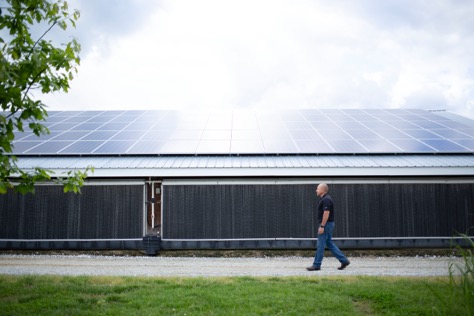
Most chicken farms have switched to LED lighting, which can result in energy savings of 80-85 percent compared to traditional incandescent lightbulbs. Modern growout houses are mostly controlled by sophisticated computers that make continuous changes in temperature and ventilation to maintain optimal environmental conditions for the chickens while saving gas and electricity.
Some chicken farmers are also installing solar panels in order to limit their energy use. For example, Terri Wolf-King installed solar panels on her farm to help lower their energy bill and decrease their environmental footprint. Since installation, she has seen a significant reduction in her energy use on her chicken farm. Tim and Deena, chicken farmers from Kentucky, also installed solar panels and have subsequently saved 60-70 tons of coal per year. “Our goal in installing the solar panels was to drastically improve our footprint and significantly lower the cost of our electricity bill,” shares Deena.
How much does chicken production contribute to greenhouse gas emissions? How is the chicken industry combatting climate change?
The production of all food – whether it’s meat, seafood or fruits and vegetables – results in greenhouse gas (GHG) emissions. According to the Environmental Protection Agency (EPA), producing chicken, turkey and eggs only accounts for 0.08% of the total U.S. GHG emissions.
The chicken industry works hard to be efficient and localize production facilities, where possible. In fact, chicken production is extremely local; the distance from the hatchery to the farm to the processing plant is usually no more than one hour away from one another. Localized production between the hatchery, farm and processing plant reduces time traveled, emissions and costs. This efficiency and localization ties directly to a reduction of GHG emissions.
The chicken industry remains committed to reducing the environmental impact resulting from the use of natural resources and byproducts of poultry production that contribute to climate change. From 1965 to 2010, the environmental impact of producing 1000 kg (2,204.62 lbs.) of liveweight poultry has been cut in half. In fact, 75% fewer resources are required to produce the same amount of chicken as 1965. These improvements have been enabled by technological advancement and improved animal husbandry practices.
What about air quality? How do farmers measure and limit ammonia?
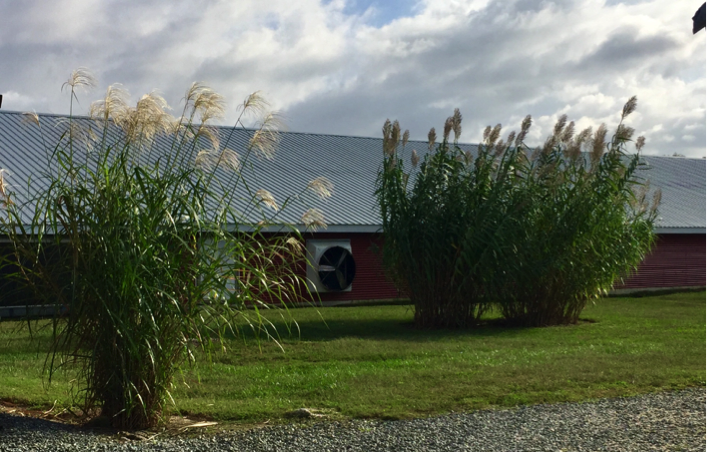
Farmers want the best air quality not only for their chickens, but for the health of their staff, family and communities. Ammonia is a natural byproduct of chicken production. For farmers, there are many solutions to help improve air quality on their farms and reduce ammonia.
For example, farmers like Terry and Jenny plant foliage around their chicken houses to capture ammonia and collect dust. These plants often serve a dual purpose of reducing potential odors.
Farmers also regularly monitor ammonia levels within their chicken houses. Certain levels of ammonia in the chicken house can be damaging to the chicken, the farmer and the environment. For this reason, farmers use litter treatments to aid in the retention of ammonia in litter, as well as ventilation and monitors to ensure the health of their flock.
Beyond the chicken meat, how is the rest of the chicken used?
Beyond your chicken breasts, wings, legs and thighs, every part of the chicken is utilized. Here are some ways that chicken is repurposed and recycled:
- Chicken feathers are especially valuable. The US poultry industry produces 1.6 million tons of feathers every year. Most feathers are ground up into “feather meal” and used as animal feed as they are an excellent source of protein for livestock. Feathers can also be used as plastic fortifiers.
- Chicken feet are known as “paws” in the poultry business. The US exports about 330 tons of chicken paws every year, mostly to Asian nations where they are considered a delicacy. In the U.S., you can find them in Asian markets and in pet stores as dog treats.
- Chicken organs, like chicken hearts and chicken livers (gizzards), are often sold in your local grocery store for human consumption. Extra chicken organs may be sent to a rendering plant to be made into pet food.
Should people eat less meat – including chicken – to save the environment? Is plant-based meat the more sustainable option?
The worldwide population is growing at an accelerating rate. And as the population grows, so does the demand for food. The broiler chicken industry is committed to meeting that rising demand for consumers, while ensuring we are using practices that lessen our environmental impact.
No matter the type of protein – plant or animal-based – there will be an environmental impact. Agriculture always has an environmental impact. That is why we keep trying to improve and minimize environmental impact.
The chicken industry is continuously looking for new ways to reduce our use of natural resources and improve the sustainability of our practices – and we know that advancements in production technology should never come at the expense of the health of our birds or of the people we’re feeding.
We are already headed in the right direction – chicken production has a smaller environmental footprint than almost any other animal agriculture industry, and we are continuing to develop and advance our sustainable practices so that we leave the earth in better shape than we found it.
